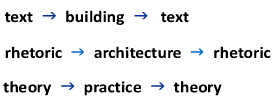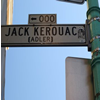To provide an overview of our experiences as members of English 696: Spatial and Visual Rhetorics at University of Arizona, I came to see Tschumi as not merely a luminary figure in architecture but also a luminous figuration to introduce the reflective pieces--which I called "movements"--of our class members. As Louis Martin’s 1990 essay “Transpositions: On the Intellectual Origins of Tschumi's Architectural Theory” suggests, Tschumi draws heavily from textual and critical theories as a means to create new generative, revolutionary treatises on architecture (p. 23). Such text-based theories are instantiated in Tschumi's projects. In other words, just as Tschumi tapped into the ways concepts in theory translate into practice, my goal is to bring his borrowed theoretical concepts back into our discussion. This return might best be articulated by this image:
 Coming
to terms with terms, however, is never easy. How do I describe, name,
and label the heterogeneous experiences among members of the graduate
seminar and the ways we have come to understand ourselves as spatial scholars,
then and now? Reflection. A fitting term in our field at once seems a
logical starting point and at another may not adequately describe the
continuous process of coming to new ideas, abandoning others, or maintaining
useful tensions or unresolved feelings and intensities, both intellectual
and personal. Seeing Rory's image of BLUE reminds me that reflections
are always already contingent, partial, and mutable. Tschumi's concept
of movement provides a figuration that works toward contradiction, heterogeneity,
complexity, and change. Rather than calling for merely reflective practice,
Tschumi posited a more radical position for architecture, one that resists
its definition as a stable or monolithic study or discipline and instead
argues that "pure space doesn't exist; pure event doesn't exist.
In other words, architecture is always dynamic in its reading, in its
perception, in terms of what is does. Eventually, I ended up by saying
that what is important in architecture in not what it looks like but what
it does" (p. 26). Thus, while reflection may be a beginning concept
for these works (and an important one no doubt), contributors to the class
turn their attention here to what spatial theory “does” and
not just how we might understand it as a theory, and in exploring what
it does, they also identify contradictions, contestations, and of course
complements in their praxes.
Coming
to terms with terms, however, is never easy. How do I describe, name,
and label the heterogeneous experiences among members of the graduate
seminar and the ways we have come to understand ourselves as spatial scholars,
then and now? Reflection. A fitting term in our field at once seems a
logical starting point and at another may not adequately describe the
continuous process of coming to new ideas, abandoning others, or maintaining
useful tensions or unresolved feelings and intensities, both intellectual
and personal. Seeing Rory's image of BLUE reminds me that reflections
are always already contingent, partial, and mutable. Tschumi's concept
of movement provides a figuration that works toward contradiction, heterogeneity,
complexity, and change. Rather than calling for merely reflective practice,
Tschumi posited a more radical position for architecture, one that resists
its definition as a stable or monolithic study or discipline and instead
argues that "pure space doesn't exist; pure event doesn't exist.
In other words, architecture is always dynamic in its reading, in its
perception, in terms of what is does. Eventually, I ended up by saying
that what is important in architecture in not what it looks like but what
it does" (p. 26). Thus, while reflection may be a beginning concept
for these works (and an important one no doubt), contributors to the class
turn their attention here to what spatial theory “does” and
not just how we might understand it as a theory, and in exploring what
it does, they also identify contradictions, contestations, and of course
complements in their praxes.
 link to event
link to event |
Martin, Louis. (1990). Transpositions: On the intellectual orgins of Tschumi's architectural theory. Assemblage, 11, 22-35.
Tschumi, Bernard. (1976). Manhattan Transcripts. New York: John Wiley & Sons.
Tschumi, Bernard. (n.d.) Blue. Retrieved April 2, 2011, from http://www.tschumi.com/projects/6/#.







